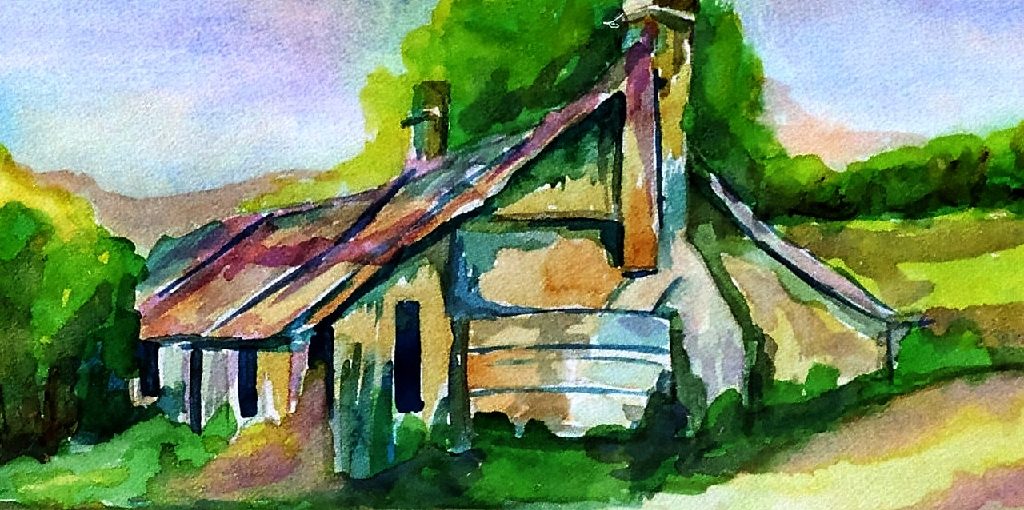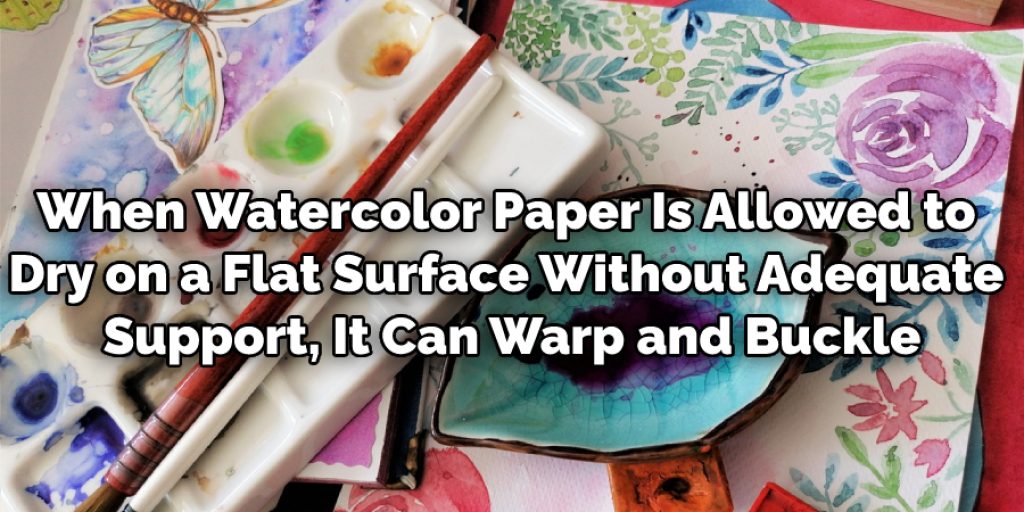How to Prevent Watercolor Paper From Warping

Watercolors are a beautiful medium of painting that many artists use to create their masterpieces. However, when the watercolor paper is left to dry incorrectly, it can warp and become unusable. This article will teach you how to prevent the watercolor paper from warping so you can continue creating amazing art pieces!
8 Reasons Why Watercolor Paper Warp:
Watercolor paper can warp for any number of reasons. However, the most common reasons are:
1. Improper Storage:
The watercolor paper should never be stored rolled up in its natural state without an archival tube or frame. This is a classic no-no for watercolorists, as papers that are allowed to warp will not retain their original shape when wet, causing them to buckle and ripple in all sorts of annoying ways.
2. Poor Drying Technique:

When watercolor paper is allowed to dry on a flat surface without adequate support, it can warp and buckle,, causing the paper to curl up at the edges. This is why many watercolorists lay their work on a flat surface in an “L” shape (with a long edge parallel to the floor) with weights along all three sides of its longest edge.
3. Immersion:
Submerging a watercolor painting without a mat board or support can cause the paper to warp and distort, losing its original shape.
4. Watercolor Pigment:
Some pigments like Quinacridone Magenta are known to cause the watercolor paper to warp more easily than others. But, of course, this depends on the paint manufacturer too! For example, Sennelier touts their pigment as extremely lightfast and with great transparency (even though I’m not a fan of their paint in general, I must admit that they make some great colors).
5. High Humidity Levels:
If you live in a humid environment, your watercolor paper has a higher chance of warping. One way to prevent this is to invest in an air conditioner or dehumidifier (whether you want to add heat or filter the air).
6. The Paper’s Weight:
Oddly enough, high-quality watercolor papers manufactured in a traditional mill tend to warp more than their less expensive counterparts. Traditional mills, like Fabriano, have taken great strides to prevent the warping of their papers by making them paper-like (without sizing) and thickening them up so they can withstand days or weeks of being wet without sagging.
7. Type of Surface:
Watercolor paper that is not primed with acrylic gesso or an oil-type ground can be more likely to warp than watercolor paper that has been prepared in this way.
8. Air Circulation:
If you live in a dry climate, you may want to invest in an auxiliary fan. The air movement from the fan will reduce the chance of watercolor paper warping by circulating air around it and effectively reducing its surface moisture content.
Steps on How to Prevent Watercolor Paper From Warping:
Step 1:
Remove the paper from its packaging and place it in a flat, dry location until ready to use. This is sound advice for any paper. It prevents creases and wrinkles, which will likely happen if you paint over them on your artwork.
Step 2:
If your watercolor paper has already been flattened out once, it is less likely to curl up again. If you can, keep it in that configuration until ready for use–static cling keeps the paper flat and prevents warping.
Step 3:
Use clips or push pins along the top edge of your watercolor paper to hold it down. This works great for keeping artwork flat on a larger surface,, such as an artist’s table.
Step 4:
Cover your artwork with a sheet of glass or Plexiglas while you paint to keep it flat and in place. This also allows for easy transport when you’re done painting, as the protective covering keeps everything together.
Step 5:
When you finish painting, leave your watercolor paper flat under the weight of another object. For instance, lay a stack of books on top of your watercolor paper overnight to flatten it out and prevent warping while it dries.
Step 6:
Use two pieces of acid-free foam board or cardboard to sandwich the edges of your watercolor paper between them while you paint. This technique is good for small paintings that require you to hold them. It also prevents warping if you plan to rotate your project while working on it.
Step 7:
Use another sheet of watercolor paper as a weight instead of heavy objects–it may be more convenient and aesthetically pleasing for some projects than glass or books, which have their own colors and textures that may interfere with the look of your project.
Step 8:
Cover your watercolor paper with a sheet of freezer paper while you paint. Once the painting is finished, freeze it for an hour or so. Take it out of the freezer and let it thaw at room temperature. As the water in the paper thaws, it expels molecular air that is trapped between layers of fibers in the wood pulp, flattening out the paper without warping it.
Step 9:
Steam your watercolor paper with an iron to reduce curling on a smaller, more delicate piece of art–be careful not to hold the iron in one spot too long or you may damage your artwork.
Step 10:
Dip your fingers in cool water and run them down the length of your watercolor paper to flatten it. The heat from your hands combined with the water will act like a steam iron on a smaller scale, flattening out small creases in no time.
Drying Your Watercolor Painting Properly
Drying watercolor paintings can seem daunting, but it can be done quickly and effectively with the right techniques! Here are some tips to help you dry your watercolor paintings properly:
- Use a large fan or hair dryer on a low setting to help speed up the drying process. Be sure not to blow too much air directly onto the painting, as this could cause the colors to move and blend together in unexpected ways.
- Place your artwork on a flat surface in an area that is well-ventilated and out of direct sunlight. This will allow for the paint to dry evenly without any uneven areas.
- Place small pieces of paper or plastic underneath the corners of your artwork to keep them from warping as it dries. This will also help prevent any unwanted smudges or marks on your work caused by movement during the drying process.
- If you notice any wrinkles in your painting while it is drying, use a soft bristle brush or a damp cloth to smooth them out before they set in place permanently gently.
- Once completely dry, make sure to store your masterpiece in an acid-free folder or container away from direct sunlight and humidity changes that could damage your work over time.
What Can You Do About Warping Watercolor Paper?

You can do some simple things to prevent your watercolor paper from warping. The most important thing is to let it dry flat and under the right conditions. We recommend using clips on the upper edge of the paper or simply pressing it flat with a piece of plexiglass or glass.
The other option is to spray your watercolor paper with a fixative when finishing your painting to prevent future warping. This will ensure that the paper remains flat during future handling. Another thing to keep in mind is storing your watercolor paper correctly. Put it back into its original packaging when finished and store it flat, preferably out of direct sunlight.
How Can I Remove Pucker Marks From My Watercolor Paper?
One way to fix pucker marks is to let your watercolor paper dry flat. Sometimes, this will be enough to correct the problem. If you feel that the pucker marks are still there after letting them dry out for several days and feel like they are too deep to fix with just drying, you can try a few ways of fixing the problem.
One way to fix this is to take a brush soaked in water and gently brush across the paper in the opposite direction of how it naturally lays. This should smooth out any pucker marks that are left on your paper. Another way to fix pucker marks is to use your iron. You can place a piece of parchment paper or wax paper over the warping watercolor paper and gently run your iron over it in circular motions.
How To Stretch Watercolor Paper For Best Results?
Stretching watercolor paper is a great way to ensure that your painting has an even surface and also prevents buckling. To get the best results, you should use a few simple steps. Firstly, soak the paper in cold water for at least 5 minutes or until it becomes saturated.
Then, lay the paper flat on a damp board or towel, evenly stretching it out from each corner to prevent it from warping. Finally, secure the edges with masking tape to keep the paper firmly in place while you paint. With these easy steps you can get professional-looking results every time!
Frequently Asked Questions
Why Does My Watercolor Paper Curl Up?
Watercolor paper can curl up because of the way it is made. The paper is made from a type of cotton that absorbs water and expands. This causes the paper to become stiffer and harder to work with, which can cause it to curl up.
Can You Flatten Watercolor Painting?
Watercolor painting is a beautiful and delicate art form that requires a lot of skill and patience. However, some techniques can be used to help flatten watercolor paintings.
One such technique is called the steamroller method. This involves spraying water onto the painting from all directions at once to soften the paint and make it more malleable.
Another technique is called the fog machine method. This involves filing a room with humid air and then blasting it onto the painting with a high-powered fan. This will cause the paint to become less sticky and easier to remove.
Is Stretching Watercolor Paper Necessary?
No, stretching watercolor paper is not necessary. However, if you are new to watercolor painting, stretching the paper before beginning your painting can be helpful. This will help to prevent the paper from sticking to your brush and making it difficult to paint with accuracy.
Do You Have to Soak Watercolor Paper?
No, you don’t have to soak the watercolor paper. However, if you use wet media like watercolor or gouache, it is best to pre-soak the paper before starting your painting. This will help remove any excess moisture and make the painting easier.
Conclusion:
Wrapping paper in plastic wrap before painting can help to prevent warping. It is also helpful to paint on top of a watercolor block or another textured surface and use plenty of moisture when brushing the ink onto the paper. When finished with your masterpiece, you must place it face down if left out for any length of time so as not to let air dry spots form on the back side, which could warp over time.
In addition, be sure to keep paintings moist by misting them periodically with clean water from an eyedropper or spray bottle while they are drying. These simple steps to prevent the watercolor paper from warping should go a long way towards preventing your next masterpiece from being ruined by warped paper!
Read On Our Other Blog – How to Reproduce Watercolor Painting




